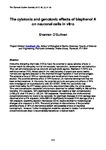The cytotoxic and genotoxic effects of bisphenol A on neuronal cells in vitro
| dc.contributor.author | O'Sullivan, S. | |
| dc.date.accessioned | 2019-05-20T12:36:14Z | |
| dc.date.available | 2019-05-20T12:36:14Z | |
| dc.date.issued | 2017 | |
| dc.identifier.citation |
O'Sullivan, S. (2017) 'The cytotoxic and genotoxic effects of bisphenol A on neuronal cells in vitro', The Plymouth Student Scientist, 10(1), p. 41-63. | en_US |
| dc.identifier.issn | 1754-2383 | |
| dc.identifier.uri | http://hdl.handle.net/10026.1/14139 | |
| dc.description.abstract |
Endocrine disrupting chemicals (EDCs) have the potential to cause adverse effects to human health by disrupting normal homeostasis, reproduction, development and behaviour. They can simultaneously act as cytotoxic and genotoxic agents. Bisphenol A (BPA) is a well-documented EDC, widely used in the manufacturing of plastic and epoxy resins. Humans are regularly exposed to this chemical through ingestion of food and beverages. The adverse effects of BPA on reproduction and development have been thoroughly studied. The potential adverse effect of BPA however, on neuronal development has not been entirely explored. In this study, the potential cytotoxic and genotoxic effects of BPA were investigated on neuroblastoma cells (SH-SY5Y). While the cytotoxicity was determined using the MTT assay, genotoxicity was determined using the comet assay. Time and concentration dependent effects were observed for cellular viability in this cell line following BPA exposure. BPA significantly reduced cell viability at high concentrations (>250 µM) after 24h and (> 100 µM) 48h exposures. Nevertheless, low environmental concentrations were not found to be cytotoxic. No significant increase in DNA damage was observed after a 24h exposure, while 500 nM significantly increased DNA damage after a 48h exposure. Scanning electron microscopy (SEM) results showed no morphological changes after exposure to BPA. This study provides in vitro evidence of the potential adverse effects of BPA on the nervous system and possible effects on neuronal development. However, further investigation would be required to decide if environmental concentrations are likely to be potentially hazardous to human health. | en_US |
| dc.language.iso | en | en_US |
| dc.publisher | University of Plymouth | |
| dc.rights | Attribution 3.0 United States | * |
| dc.rights.uri | http://creativecommons.org/licenses/by/3.0/us/ | * |
| dc.subject | Endocrine disrupting chemicals | en_US |
| dc.subject | human health | en_US |
| dc.subject | homeostasis | en_US |
| dc.subject | reproduction | en_US |
| dc.subject | development and behaviour | en_US |
| dc.subject | cytotoxic and genotoxic agents | en_US |
| dc.subject | Bisphenol A | en_US |
| dc.subject | neuronal cells | en_US |
| dc.subject | in vitro | en_US |
| dc.title | The cytotoxic and genotoxic effects of bisphenol A on neuronal cells in vitro | en_US |
| dc.type | Article | |
| plymouth.issue | 1 | |
| plymouth.volume | 10 | |
| plymouth.journal | The Plymouth Student Scientist |



